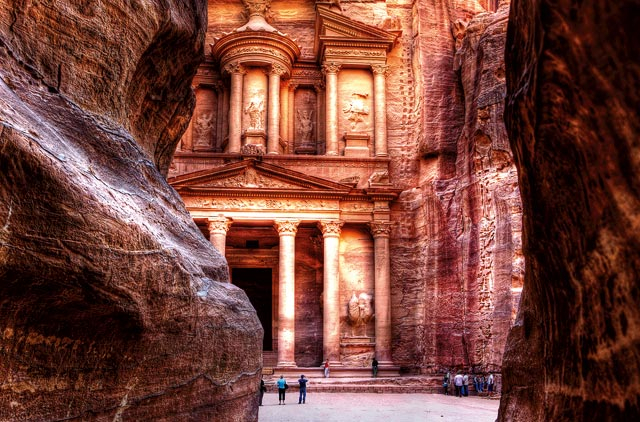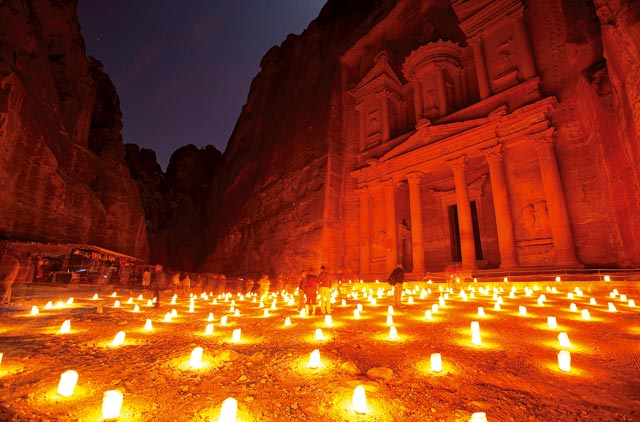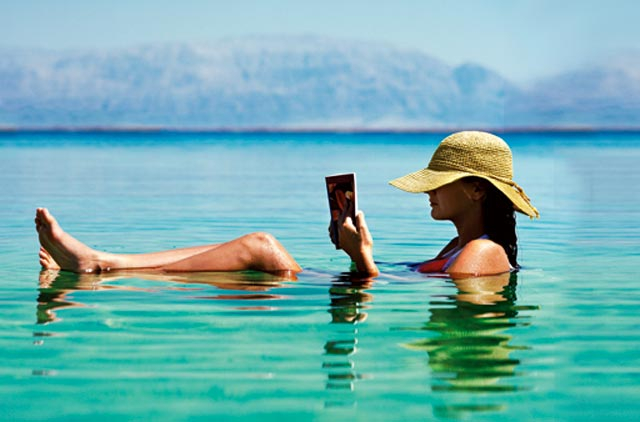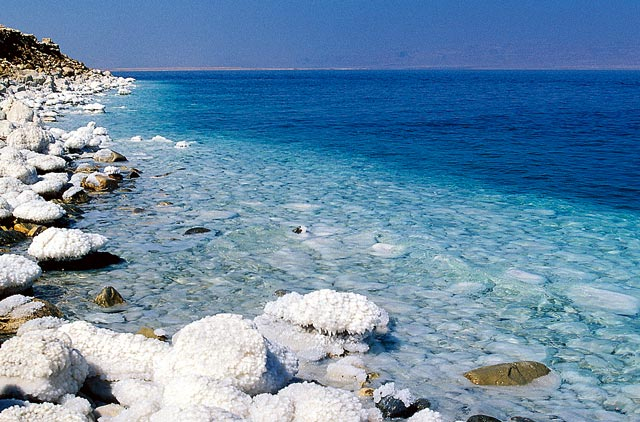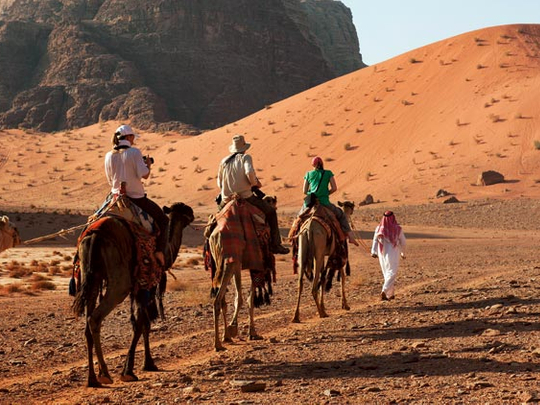
DAY 1: AQABA
After arriving in Amman, the country’s capital located in the north, I am driven with a tour guide the 400km journey to Jordan’s most southern city, Aqaba. The fact that it takes just four hours to get from the main city in the north to the one in the south is testament to how easy it is to explore this historically rich and culturally diverse country within such a short space of time. And getting around is pretty affordable, too. A shared taxi from Amman to Aqaba costs just 10 dinars (Dh52) one-way; a shared bus Dh39; and a VIP bus service (think toilets, movies and snacks) is Dh93. Visit www.jett.com.jo.
And far from being a dull four hours, the road trip reveals a landscape which, as I discover over the next five days, is as diverse as the country’s many offerings. We pass lush green valleys, undulating red sand dunes and take winding roads through sandstone mountains. There are also lots of stop-off points along the way, and one not to miss is Midway Castle, halfway between Amman and Petra. The touristy spot sells an intriguing selection of souvenirs, religious memorabilia and Dead Sea beauty products, and is my first introduction to the very addictive sweet mint tea they love here.
Warm and balmy, with tonnes of touristy shops, swaying palm trees and a seaside atmosphere, the port of Aqaba is Jordan’s only coastal city and its only outlet to the Red Sea, the best dive waters in the world. In fact, the Gulf of Aqaba is renowned worldwide for its underwater sea life – 140 species of coral, 1,000 species of fish, turtles, whales, dolphins and sea cows – and all the major beachfront hotels here offer diving and snorkelling trips.
The town itself is not much to write home about, but it’s worth strolling around the local market for souvenirs and enjoying lunch at one of the many seafood restaurants, where the fish is the freshest you’ll find anywhere. We lunch on the pretty garden terrace of the unpretentious Floka Restaurant – you choose from a ‘catch of the day’ list (think sea bream, grouper and snapper) which is then cooked any way you like and served simply with salad and chips.
Aqaba is all about the beach and sea, so if you’re not diving, doing water sports or taking a dip in the waters after chilling on the beach, then book a glass-bottomed boat trip – most hotels, including the Mövenpick Aqaba, offer them. It’s a scenic ride as Aqaba is surrounded by colourful mountains and you can see the shores of several countries, including Egypt. We stop in various locations to view the incredible sea life through the glass; to jump into the crystal-clear waters and snorkel; and finally, at sunset, to enjoy a meal of freshly caught fish and salad.
DAY 2: WADI RUM
From Aqaba, we drive an hour north to one of the world’s most outstanding desert landscapes, Wadi Rum, famous for once being inhabited by Lawrence of Arabia. In his autobiography, Seven Pillars of Wisdom, Lawrence describes Wadi Rum as “…vast, echoing and godlike”, while the late Neil Armstrong once likened it to the surface of the moon. It is all of this and more as I soon discover from the back of an open-air truck.
After checking in to my desert camp, Captain’s Desert Main Camp, I’m whisked off by a Bedouin guide to explore. Wadi Rum is a complex network of wadis dotted with towering weathered sandstone rock formations (over the centuries, wind and rain have sculpted the sandstone into weird shapes like mushrooms and strange textures like melted wax) in colours of red, yellow and orange. These shades spill over to colour the undulating sand dunes, creating amazing pink sand.
The ride is bumpy and dusty but spectacular. The emptiness and magnificence of something so natural creates a deep sense of tranquillity.
We stop off at various points to take in the views, climb aboard a camel for a quick jaunt over the sand dunes and break at a Bedouin tent for tea. The final stop is a magnificent rock, which we climb to enjoy the sun setting over this spectacular landscape. There is also the opportunity to ride horses through Wadi Rum.
We return to camp where I’m shown my tent. Though it is designed to replicate an authentic Bedouin camp with goat-hair tents, it does (thankfully) offer real beds with real mattresses and blankets. Adjacent to the tents is a huge open-air restaurant, with lantern-lit palm trees overlooking the majlis-style seating. And dinner here is a dramatic affair, served to the sounds of a solo oud player. Cooked in the traditional way, using a Bedouin zarb – lamb, chicken with potatoes and onions are cooked using an underground charcoal grilling method – we dig into a feast of meat (most tender I’ve ever had) served with Bedouin mansaf rice, stacks of warm flat bread, and cooked saffron yoghurt.
Post dinner, under a million glittering stars, we sip super-sweet mint tea, dance to drum beats and finally collapse around the campfire chatting into the early hours.
DAY 3: PETRA
A 90-minute to two-hour drive north of Wadi Rum, the ancient Nabataean city of Petra, a Unesco World Heritage Site, is half-built, half-carved into the rock, surrounded by mountains riddled with passages and gorges. We access the city through a narrow 1.2-km sandstone gorge (or siq) that winds downhill with 200m-high rose-coloured walls that dramatically soar skywards on either side. It’s a fascinating walk – or ride, if you hire a horse cart (Dh104) – as the walls of the siq change colour.
It’s a jaw-dropping moment as you reach the end of the siq and spot Petra’s most famous monument, the Treasury – a 39m-high carved tomb that was used in the famous final sequence of the film Indiana Jones and the Last Crusade. “It’s a dramatic moment when many people are reduced to tears,” says my guide.
But there’s much more to Petra than just the Treasury. Various walks and climbs reveal more than 800 buildings, tombs, baths, funerary halls, temples, colonnaded streets and rock drawings – certainly much more than you can see in one day. The 3,000-seat amphitheatre is a must-see, while the spectacular views from the First-century monastery make climbing the 827 steps well worth it.
There’s a lot of walking and climbing involved and it can be hot and sweaty work, but there’s the option of hiring a donkey or camel en route to ease the load, or stopping off at one of the little cafés for a mint tea and perusing the touristy artefacts. We stop off at one such tourist shop where my guide introduces us to the owner who turns out to be Marguerite van Geldermalsen, the New Zealand-born nurse who, after visiting the Middle East in 1978, fell in love with a Bedouin and stayed. Since then she’s been resident nurse here, living in a 2,000-year-old cave. Her sons run this souvenir store in Petra and she often visits, signing her book Married to a Bedouin for tourists, a copy of which I promptly snap up.
Our group is late to leave Petra and I’m pleased: the sunset casts a warm pink hue over the monuments; it’s ‘happy hour’ for tourist gifts – 50 per cent off; and galloping back to the entrance on horseback in the eerie silence is exhilarating – a horseback ride to or from the siq is included in your one-day entrance ticket (Dh260). After a sweaty day of walking and climbing, treat yourself to a traditional mud bath – literally a mud bath that’s both relaxing and leaves skin as smooth as a baby’s bottom – in Wadi Musa (the town in which Petra is set), or stop in one of the many local cafés and down a refreshing Bedouin whisky, a special tea with eight different herbs, including marjoram and thyme. In need of total relaxation, I take both options.
We return to Petra a few hours later for an organised Petra by Night Tour, an experience that’s well worth the Dh62 price tag. Darkness is pricked eerily by some 1,800 candles leading you along the siq to the Treasury where a lone man plays the rebab, a violin-like instrument, while singing reverberates around the Treasury. It’s an out-of-this-world experience that’s haunting, mesmerising and romantic. Tours run three times a week, from 8.30pm.
On our return to the hotel, the three-star Crown Plaza Resort, which is just a stone’s throw away from Petra and where actors Sean Connery and Harrison Ford stayed in 1991 during the making of Indiana Jones and the Last Crusade, we visit the Cave Bar – a 2,000-year-old Nabataean tomb that’s been turned into a delightful bar and restaurant. We sit in little side tombs and cook our own mini barbecues on a hot plate at our table, while sipping cocktails and listening to the live Bedouin band. An incredible end to an incredible day.
DAYS 4&5: DEAD SEA
From Petra we head north to the Dead Sea, about a two-hour drive. There are several historical sites near here that are worth visiting, including the mosaic city of Madaba, the Baptism Site and Mount Nebo. We choose the last. We climb the 700-metre hill to Mount Nebo, said to be the burial place of Moses, and enter the site (Dh5). It’s here that Moses was believed to have seen ‘the holy land’ and the views are spectacular, including the churches of Jerusalem on the West Bank.
We reach The Dead Sea – 400 metres below sea level and the lowest point on the earth’s surface – by lunchtime. It’s a strange phenomenon – this totally flat and still black body of water that is, explains our guide, “evaporating, with a serious risk of drying up in 50 years.” And you can see the evidence – mounds of salt clinging to rocks where it’s already depleted.
We check into one of the Dead Sea’s five-star hotels, the Holiday Inn Dead Sea Resort, where my room is just a two-minute walk from the sea. If you’re not so lucky – staying in a hotel without Dead Sea access, or visiting the area just for a day – you can still experience the Dead Sea via several public beaches just two kilometres past the hotel area.
As we make our way down to the Dead Sea, my guide explains that many people visit specifically for the water’s therapeutic qualities. It’s so rich in minerals that it’s been proven to help cure psoriasis and help ease arthritic conditions, while the quality of air (10 per cent richer in oxygen than at Mediterranean sea level and with low pollution levels) is beneficial to those suffering from respiratory conditions.
For those of us without ailments, the Dead Sea still has plenty to offer. Floating in the sea (you can’t swim, only bob) turns out to be an incredibly relaxing – albeit surreal – experience and is also nourishing for the skin. For double the nourishment, my guide suggests I smear myself with the shoreside mud. Known as Dead Sea therapeutic black mud, its mineral-rich qualities are said to cleanse and detox skin, help increase circulation and even ease joint discomfort. I spend a good two hours covered in mud bobbing about in the salty water, while reading a book, and due to the continuous haze over the sea, which filters out much of the UVB rays, I don’t have to worry about sun damage.
The experience is so relaxing that I awake early the next morning for another mud wrap and float, before heading off to the nearby wonder of Hammamat Ma’in, an amazing desert oasis with hot springs 264 metres below sea level. These natural thermal waterfalls feature mineral-rich waters, heated up to 63˚C by underground lava. We spend all afternoon relaxing here – it costs Dh78 for the day. If you’re in need of further pampering, visit the luxurious Evason Ma’In Hot Springs Six Senses Spa situated at the springs, which offers unusual treatments such as underwater massages. You can also stay overnight or book one of their three-day packages, from Dh9,930.
After two very relaxing days, I am back on the road again, up to Amman to take my short flight back to the UAE. My five-day journey through Jordan has been incredibly varied – historically interesting, culturally diverse and rich in so many different experiences. And so much diversity in such a small area means it’s perfect for those short on time, as you can cram in what feels like a two-week break in just a few days, all without breaking the bank.
THE DETAILS
GETTING THERE
Royal Jordanian Airlines offers eight flights a day, from Dh1,530 return. Flydubai offers ten flights per week, from Dh1,023. MORE INFORMATION Visit www.visitjordan.com for general information and www.rscn.org.jo for information on campsites and lodges and to book tours and trips
WHERE TO STAY
AQABA
There’s something to suit all budgets here, from the five-star hotels like The Kempinski and The Mövenpick, with their sea-facing rooms and private beaches, to the many three-star hotels within the town. Or try the budget-friendly Darna Village on South Beach – it offers rooms overlooking the Red Sea, a restaurant serving fresh seafood and a dive centre. From Dh78 per night, including breakfast. Email darnavillage@gmail.com.
WADI RUM
There are lots of overnight desert camps. Captain’s Desert Main Camp (www.captains-jo.com) is set just 300 metres north of the protected area. A double tent with breakfast costs Dh257 per night. Or try Rahayeb Desert Camp (www.rahayebcamp.com), which is nestled in a picturesque canyon and has tons of desert-based experiences for kids and adults including star gazing nights, foot print tracking adventures, Middle Eastern cooking lessons and desert survival skills.
PETRA
There are some 85 hotels to choose from in Petra, but the three-star Crowne Plaza Resort is the most convenient, a stone’s throw away from Petra’s entrance. Or try Ammarin Bedouin Camp (www.bedouincamp.net) in Beidha, 10 kilometres north of Petra, run by the local Ammarin tribe. An overnight stay with dinner and breakfast is Dh253. Bargain!
THE DEAD SEA
At the Arabesque-style Holiday Inn Dead Sea Resort, each room has its own terrace or balcony with views of the mountains and sea, and access to the Dead Sea is just a two-minute walk away. Meanwhile, the five-star Mövenpick Hotel is a traditional village setting among lush gardens and features the award-winning Zara spa. Or escape the tourists with a chalet stay near the Mujib Nature Reserve on the shores of the Dead Sea. Mujib Chalets is a seaside sanctuary on the Dead Sea Highway opposite the Wadi Mujib Visitors Centre. Facilities are basic but the views of the mountains and Dead Sea from your hammock on your chalet terrace are stunning. You get access to the sea and they even keep you supplied with therapeutic Dead Sea mud. To book, visit www.rscn.org.jo.


